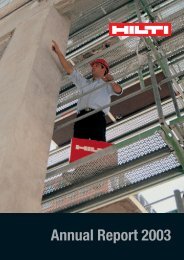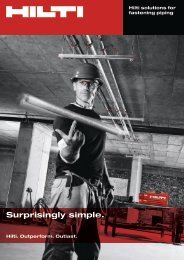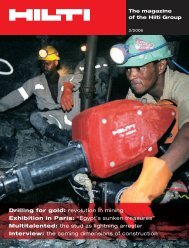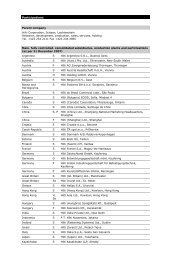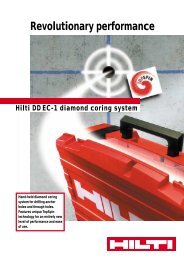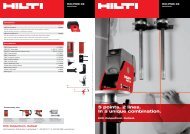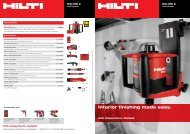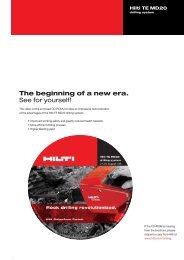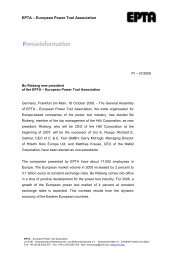Netherlands: high-tech fastening for high-speed track ... - Hilti
Netherlands: high-tech fastening for high-speed track ... - Hilti
Netherlands: high-tech fastening for high-speed track ... - Hilti
Create successful ePaper yourself
Turn your PDF publications into a flip-book with our unique Google optimized e-Paper software.
Magazine Fall/Winter 2005<br />
Engineering<br />
Page 15<br />
Don’t <strong>for</strong>get, you’re<br />
below sea level<br />
here,” says engineer Harry Kolk<br />
as his eyes follow the light-colored<br />
band of concrete that vanishes into<br />
the horizon. We’re at the site of the<br />
dual-line, <strong>high</strong>-<strong>speed</strong> railway being<br />
built between Amsterdam and<br />
the Belgian border, part of it on reclaimed<br />
land now protected by<br />
dikes. Harry Kolk’s gaze returns to<br />
the spot on which he’s standing.<br />
Thick steel dowels project at his<br />
feet: <strong>high</strong>-<strong>tech</strong> <strong>fastening</strong>s <strong>for</strong> <strong>high</strong><strong>speed</strong><br />
<strong>track</strong> on which trains will<br />
run at up to 330 kilometers per<br />
hour. In a few minutes, the dowels<br />
will disappear under the layer of<br />
concrete poured around the sleepers<br />
on the slab <strong>track</strong>.<br />
The same day, at a different location<br />
on this band of concrete,<br />
Danny Mangal opens his ears: “I<br />
listen <strong>for</strong> the signal of course, but<br />
that’s about all there is to it,” he<br />
says. The signal, indicating the position<br />
of a rebar in the concrete, is<br />
emitted by the <strong>Hilti</strong> Ferroscan detector.<br />
“Meet a good friend of<br />
mine,” says Danny, pointing to the<br />
<strong>Hilti</strong> Ferroscan unit. His workmates,<br />
using a template, have<br />
marked out the projected positions<br />
of the steel dowels on the strip of<br />
non-woven fabric, a so-called geotextile,<br />
covering the concrete substructure.<br />
Danny Mangal runs the<br />
<strong>Hilti</strong> Ferroscan detector along the<br />
geotextile to ensure that the positions<br />
of the holes <strong>for</strong> the dowels<br />
don’t coincide with the steel rein<strong>for</strong>cing<br />
bars in the concrete below.<br />
Also on the same day, Peter<br />
Schaap, the man responsible <strong>for</strong> all<br />
of the work being carried out,<br />
strides into his temporary site office.<br />
His tousled hair gives him the<br />
look of someone who has just<br />
Peter Schaap: “Each construction<br />
team must complete<br />
300 meters every day.”<br />
leaned out the window of a fastmoving<br />
train. “We’re setting about<br />
750 dowels a day, and each construction<br />
team has to complete a<br />
stretch of 300 meters every day.”<br />
The south stretch of the <strong>track</strong> between<br />
Rotterdam and the Belgian<br />
border has to be completed by<br />
April 2006 and the north stretch<br />
from Amsterdam to Rotterdam six<br />
months later. After testing, the<br />
trains will go into scheduled service<br />
on the total of 90 kilometers of<br />
<strong>track</strong> a year after the completion<br />
date.<br />
Flashback to the <strong>Hilti</strong><br />
Research Center in<br />
Liechtenstein, Christmas<br />
2003: down in the cellar, powerful<br />
hydraulic units are running day and<br />
night, generating a hydraulic pressure<br />
of up to 280 bar that applies a<br />
shear <strong>for</strong>ce of 33 kilonewtons and<br />
simulated tensile stress ten million<br />
times to each of the dowels on the<br />
test rigs in 4 tests running simultaneously.<br />
You can read more about<br />
the tests on page 20.<br />
The solution with the dowels was<br />
developed toward the end of the<br />
summer of 2003 by a team of <strong>Hilti</strong><br />
consultants and research engineers<br />
who specialize in shear connection<br />
and the construction of slab <strong>track</strong><br />
rail systems. The system calls <strong>for</strong><br />
nine round stainless steel dowels to<br />
be set in the center section of each<br />
of the 6.4-meter concrete slabs that<br />
<strong>for</strong>m the superstructure of the<br />
<strong>track</strong>. These dowels will take up<br />
the <strong>high</strong> dynamic <strong>for</strong>ces generated<br />
by the <strong>high</strong>-<strong>speed</strong> trains in transverse<br />
and longitudinal directions,<br />
without displacement, and transfer<br />
them to the solid substructure. The<br />
type of steel chosen by the <strong>Hilti</strong><br />
specialists remains their secret but<br />
it has been made clear that the tensile<br />
yield strength of A4 stainless<br />
steel would not have been adequate<br />
<strong>for</strong> the purpose. With a view to preventing<br />
direct contact between the<br />
superstructure and substructure,<br />
already separated by the geotextile,<br />
the <strong>Hilti</strong> engineers wrapped<br />
the upper sections of the round<br />
bars in a thin plastic foil.<br />
As temperature fluctuations cause<br />
expansion and contraction of the<br />
concrete slabs of the superstructure,<br />
provision was made <strong>for</strong> an expansion<br />
joint with a width of 10<br />
centimeters between each of the<br />
slabs. The dowels at both ends of<br />
the concrete slab have also been<br />
designed to allow longitudinal expansion.<br />
At the same time, these<br />
dowels are also required to take up<br />
<strong>high</strong> dynamic loads, although only<br />
in a transverse direction. The <strong>Hilti</strong><br />
engineers proposed use of a round<br />
bar, the upper part of which has<br />
two flat surfaces, like a bar that has<br />
been squashed from both sides.<br />
The lateral <strong>for</strong>ces act on these flat<br />
areas. To ensure correct behavior<br />
of the dowels under the influence<br />
Switch to dowels<br />
Civil engineering works such as<br />
bridges or viaducts have their<br />
own set of rules when it comes to<br />
behavior under dynamic loading.<br />
Slab <strong>track</strong> railway substructures<br />
were originally cast in concrete in<br />
the <strong>for</strong>m of a trough. The trough’s<br />
side walls took up transverse<br />
<strong>for</strong>ces. Later, a ridge-like hump in<br />
the center part of the substructure,<br />
known as a corbel, took over<br />
from the trough design.<br />
As a result of being built on piles,<br />
the characteristics of this <strong>high</strong><strong>speed</strong><br />
rail <strong>track</strong> substructure in<br />
the <strong>Netherlands</strong> can be compared<br />
to those of a bridge. Accordingly,<br />
the engineers were required<br />
to even further optimize<br />
the dynamic behavior of the superstructure<br />
relative to the statically<br />
fixed load-bearing substructure<br />
layer, the settlementfree<br />
plates. “We there<strong>for</strong>e had to<br />
adapt the Rheda 2000 system by<br />
making use of segmented short<br />
slabs individually designed <strong>for</strong><br />
each settlement-free plate,” explained<br />
Detlef Obieray, Deputy<br />
Project Manager with Rheda<br />
2000 vof, the Infra<strong>speed</strong> subcontractor<br />
responsible <strong>for</strong> constructing<br />
the <strong>track</strong>. A corbel was<br />
out of the question as the substructure<br />
with a thickness of 70<br />
centimeters had already been<br />
completed. As the thickness of<br />
the superstructure could not exceed<br />
24 centimeters, the depth<br />
of coverage over the corbel<br />
would not have been adequate in<br />
any case. <strong>Hilti</strong> devised the solution<br />
with the <strong>Hilti</strong> HCD-C and<br />
HCD-O concrete dowels specially<br />
<strong>for</strong> this project.



